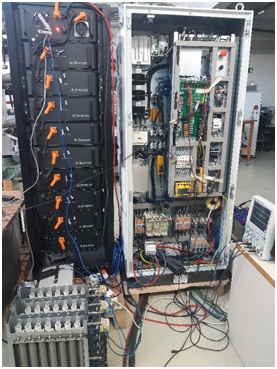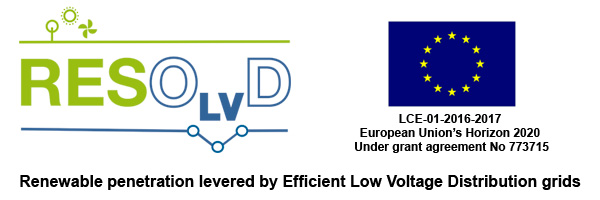Getting the best from complementary battery types – Power Sharing Algorithm
One of the main concepts underpinning EU H2020 RESOLVD project is the hybridization of energy storage systems as a way to maximize technical and economic performance of storages and simultaneously provide various services to end user(s).
In RESOLVD, the concept of hybridization is actually addressed by the development of a modular power electronics cabinet (Power Electronics Device, PED, hereinafter) that integrates a heterogeneous grouping of batteries. In RESOLVD, the PED integrates a 30 kWh Lithium-ion pack (LFP type) and a 14 kWh Lead-acid pack.
The PED, rated at 75 kVA, provides services related to power quality improvement and renewables integration capacity in a rural low voltage system. This services are thus targeting an enhanced performance of Distribution System Operator. The PED is being developed and tested by the project partner CITCEA-UPC.
The PED is being installed in the pilot of the project at the time of publishing this news article –a rural grid in the village of L’Esquirol, reaching the Catalan Pyrenees, Spain–.
In real operation, the end user, in our case the DSO, will recurrently send to the PED an operation schedule for the next 24 hours, based on the services it has to provide. Such schedule is received by the PED local manager (so-called Intelligent Local Energy Manager, ILEM), and more specifically by one of its modules, which is called Power Sharing Algorithm, PSA.
The PSA is based on non-linear programming to solve the optimization problem that, based on the status, technical performance and degradation mechanisms of each battery type, distributes power demand among the different battery types embedded into the PED. All in all, it permits to operate each of the battery types synergistically, towards an overall minimum cost (maximum lifespan of batteries and energy efficiency).
What are the specific DSO needs addressed in the project and how are these linked to the hybrid energy storage system?
There are services related to the power quality improvement (e.g. reduction of phase unbalances and current harmonics, smoothing of fast fluctuations of power flows; compensation of reactive currents as well). For such services, little or none active power exchange with the grid is needed from a battery.
The load is in the power ratings of the associated power electronic modules to the batteries instead; for batteries, it is on providing short time response and high cyclability. For such services, the performance of lithium-ion batteries can be exploited. On the other hand, other services such as the balancing or time shifting of renewable generation according to technical grid constraints (e.g. congestion), market premises (e.g. electricity price), and consumer habits (e.g. consumption profiles) require to smoothly exchange the energy stored in batteries in an hourly basis. For such services, the load of lithium-ion batteries can be reduced by also exploiting cheap lead-acid ones.

